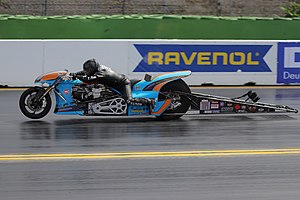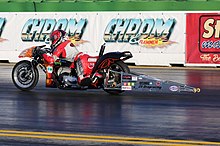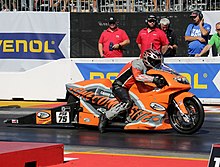Drag bike
Drag bikes or drag racing bikes are motorcycles that have been specially designed or modified for drag racing (acceleration races). Drag bikes are characterized in particular by large-volume, mostly turbocharged engines with very high power and by (in most classes) wide drive wheels and so-called “wheelie bars”.
history
Like cars, bike drag racing began in the USA. Here, too, the sport developed from the illegal races from traffic light to traffic light to an orderly process with fixed rules. The first officially approved race was hosted by the American Motorcyclist Association (AMA) in Pomona, California in 1953.
Initially, the modifications were mainly limited to “stripping” the bikes, i.e. removing all “unnecessary” ballast. First attempts with treadless tires and the stiffening of the rear swing arm followed.
In the 1960s and 1970s attempts began to install multiple engines in a row. Together with specially made frames, screwed-on compressors and self-constructed primary drives , these area bikes emerged which, with their three Honda or Kawasaki four-cylinder engines installed one behind the other , were almost impossible to control, both technically and physically. One of the protagonists of this time was the Dutchman Henk Vink.
The next step was a return to the "one-motor philosophy", which reinforced (or reproduced) proven series engines including gearboxes so that they could process performance-enhancing substances such as laughing gas or nitromethane . In the Top Fuel area, specially manufactured, extremely expensive engine blocks and cylinder heads , some of which are milled from the "solid" ( aluminum block), are used today, which are clearly superior to the series components manufactured in casting molds in terms of tolerance accuracy and stability. These engines enable times of 5.662 seconds and top speeds of 403.22 km / h over the quarter mile (402.3 meters). The Super Street Bike class has long been the leader in the use of nitrous oxide injection . After initial difficulties with metering, the development of programmable controls has led to remarkable results. The SSB is now using turbo technology. The Pro Stock Bikes opted for the “classic”, purely mechanical tuning .
Sportsman classes
Harley-Davidson V-Rod Destroyer
The Destroyer Cup, launched in 2006 by the US motorcycle manufacturer Harley-Davidson in Europe, is an amateur racing series . The riders compete against each other on drag bikes of the type Harley-Davidson VRXSE V-Rod , which are technically the same apart from minor modifications, such as to the ignition. The twin-cylinder engines, bored out to 1300 cm 3, develop 165 hp (123 kW). The motorcycles weigh around 250 kg and cover the race distance of a quarter mile in less than ten seconds. However, the future of this racing series is questionable. At the moment (2019) the series is no longer advertised in Europe, a few V-Rods compete in various sportsman classes.
ET bike
The class "ETBike" (from English "Elapsed Time" = elapsed time) has been advertised in Europe for several years. A class abbreviation that is also used is SOE (Street Only Eliminator). Located between street bikes and the much more cost-intensive super street bikes, the ETB are the entry-level class. In this class there is a large variety of brands and types with different engine concepts. There is no fixed time frame in which the participants move. Times between 9,000 and 11.999 seconds are driven. Trained or experienced drivers can achieve “high 8 times” on well-groomed routes, i.e. less than 9 seconds. The ET bikes reach approx. 250 km / h in 9 seconds.
Funny bike
In the “FB” class you will find a wide range of different bike concepts. Both two and four cylinders are permitted. Often “no longer state-of-the-art” bikes from higher classes (e.g. Top Fuel, Pro Stock, Competition) are adapted to the regulations through modifications and used. The teams use compressors, turbochargers and / or nitrous oxide (N 2 O) to increase performance . Petrol or methanol can be used. The frames are special constructions. Treadless slick tires with better grip are used, wheelie bars are mandatory. The quarter mile times for the best drivers are around 7 seconds, with top speeds of more than 300 km / h. Every now and then (mainly in Europe) Funny Bikes also compete in the Top Fuel class, where their technology is easier to master and their greater reliability.
Great twin top gas bike
In the "STTG" (or TG) class, power units based on Harley-Davidson two-cylinder engines dominate the technology. But Ducatis, Hondas or self-made products are also occasionally used. The displacement is not regulated, but is usually between 2000 and 2850 cm 3 . The chassis are either heavily modified or completely special constructions. Mechanical charging such as a compressor or turbocharger are allowed, slicks and wheelie bars are also compliant. Injection of nitrous oxide is prohibited. The engines, which run on knock-proof petrol, generate around 400 hp (294 kW). The times for a quarter mile are 7.4 seconds on well-groomed stretches and the top speed is around 280 km / h. The “Top Gas” class has had its own (not FIM-regulated) championship for many years.
Gallery (Sportsman Classes)
Pro classes
Junior Drag Bike (FIM / E)
The Junior Drag Bike (JDB) class was introduced to promote young talent and to introduce them to the sport for the first time. For the 2018 season it received the FIM Europe award, which includes the hosting of an officially recognized European championship. The class is divided into 3 sub-categories (Stock / Modified / Pro), which bring the age of the driver (between 8 and 17 years) and the performance of the engines in relation. The machines have a maximum displacement of 250 cm 3 and sometimes reach speeds of over 140 km / h. The eighth mile (201.17 meters) is set as the race distance.
Per Stock Bike (FIM / E)
The "PSB" have very strict regulations: only classic tuning. Only mechanical tuning and processing of the motorcycles is permitted. Almost all of the motorcycles have a tubular space frame and a one-piece body replica, which is based on a standard street motorcycle. Any increase in performance through nitrous oxide, compressors, turbochargers and the like is prohibited. The tuners of the top teams achieve performance increases of up to 600 hp (441 kW). The engines are mostly four-cylinder with a displacement between 1500 and 1755 cm 3 . Two-cylinder V-twin versions are also used, which allow a maximum displacement of 2608 cm 3 . Both configurations allow times in the range of around 7 seconds and speeds of just over 310 km / h.
Super Street Bike (FIM / E)
The "SSB" began in the 1990s as an entry-level class for Japanese 4-cylinder units, but went through a rapid technical and professional development in the 2000s, which led to the inclusion of the class in the UEM-FIM / E calendar. Turbochargers, compressors or nitrous oxide (N 2 O) may be used to increase performance . Only gasoline is permitted as fuel. Only commercially available road tires may be used. Wheelie bars are prohibited. The quarter mile times are in the top field at the 7-second limit, although this mark has already been undercut several times. The important “200 mile mark” (321.869 km / h) has already been clearly exceeded (341.33 km / h).
Technical development In the mid-1990s, the Super Street Bikes were rigid frame designs without any suspension and clad with one-piece body casts made of plastic. The most common measure to increase the performance of the mostly used Suzuki GSX and GSX / R engines was the use of laughing gas, which was injected directly into the intake funnel of the carburettor via so-called fogger nozzles. In order to be able to better dose the suddenly occurring massive increase in output, clocked nitrous oxide controls, "controllers", were developed. At the same time, there were first attempts with data recording (with 3 sensors) to make it easier to set up the bikes. In order to achieve a maximum contact surface ( traction ) with the prescribed road tires , tire pressures of 0.1 bar were sometimes used. In such a configuration times between 8.4 and 8.0 seconds over the quarter mile were possible.
From 2005 there was a paradigm shift : With the increased use of SSB bikes of the Suzuki Hayabusa model and the meanwhile professionalized data acquisition (12 sensors), the rigid frames disappeared in favor of a traction-promoting rear wheel suspension, and nitrous oxide injection was replaced by the use of more easily controllable turbochargers. The times improved within a short time by more than 1 second over the quarter mile. These bikes, built according to the European FIM regulations, currently (as of January 2020) achieve results of 6.804 seconds at 349.21 km / h over the quarter mile.
Super Twin Bike (FIM / E)
See also: Top Fuel
The two-cylinder "STTF" generally come from US specialist companies and outwardly resemble the engines of the traditional Harley-Davidson brand. The displacement is limited to 3000 cm 3 for naturally aspirated engines . Charging by means of compressors or turbochargers is permitted, the maximum permissible displacement is then 2000 cm 3 when using 90% nitromethane and 1700 cm 3 when using up to 100% nitromethane. The engines deliver around 800 hp (588 kW) and allow quarter mile times of less than seven seconds.
Top Fuel Bike (FIM / E)
See also: Top Fuel
The class "TFB" is hardly subject to any restrictions with regard to possible modifications. This is where motorcycles start which are mostly constructed in a 4-cylinder in-line design. Similar to the Super Twin Bikes, the motors are custom-made, which are usually milled from solid. Nitromethane is prescribed as fuel . The use of compressors or turbochargers is permitted. When using naturally aspirated motors, one or two motors with a maximum displacement of 3200 cm 3 are permitted as a drive. The maximum permitted displacement for charged 4-cylinder engines is 1700 cm 3 , for charged 2-cylinder engines 2000 cm 3 . Top fuel bikes generate over 1,000 hp (735 kW) and cross the finish line at around 380 km / h in less than 6 seconds.
Technology: Compared to the other drag bike classes (and also all other motorcycles), TF bikes have a special feature: the cylinder heads are mounted “upside down”. The inlet side with the intake components (carburettor, compressor) mounted in front of it is at the front, the outlet side with the exhaust system at the rear. This enables a better supply of the engine with oxygen (through a more direct flow) and a faster, more straightforward disposal of the exhaust gases. Due to the short race distance, the exhaust system does not need to be cooled by the airstream (as with series motorcycles).
Web links
- FIM European Drag Bike Championships 2019
- Dragbike.com (Motorcycle Drag Racing worldwide)
- Puma Engineering (manufacturer of top fuel high-performance engines)
- YouTube: DRAG Bikes & Motorcycles at NitrOlympX 2017 Combination of several bike classes
- YouTube: FIM Super Street Bike 2018 - Main Event Very detailed report about SSB at the race in Santa Pod (en)
swell
- Rules of the FIM (PDF; 150 kB)
- Rules of the DMSB ( Memento from December 6, 2013 in the Internet Archive ) (PDF; 207 kB)
Individual evidence
- ^ A History of Motorcycle Drag Racing's Sanctioning Bodies. Retrieved February 21, 2020 .
- ↑ a b c eurodragster.com: European Bests. eurodragster.com, 2019, accessed January 15, 2020 .
- ↑ http://www.zat-suedbaden.de/ZAT-SUEDBADEN.DE/PDF/BW-Timing/
- ^ Nitrolympx / Hockenheimring: Drag Racing through the ages . In: Hockenheimring BW (Ed.): Nitrolympx program booklet . tape 2017 , 2017, p. 07 .












